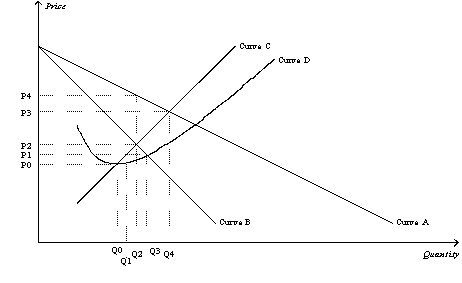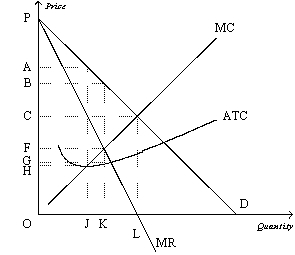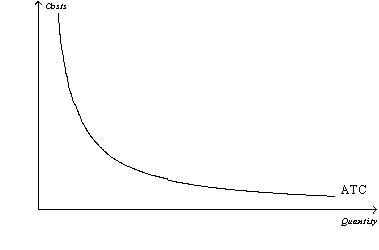A) (B-F) *K
B) (A-H) *J
C) (B-G) *K
D) 0.5[(B-F) *(L-K) ]
Correct Answer

verified
Correct Answer
verified
True/False
Suppose a profit-maximizing monopolist faces a constant marginal cost of 20 dollars produces an output level of 100 units,and charges a price of 50 dollars.The socially efficient level of output is 200 units.Assume that the demand curve and marginal revenue curve are the typical downward-sloping straight lines.The monopoly deadweight loss equals 1,500 dollars.
Correct Answer

verified
Correct Answer
verified
Multiple Choice
Financial aid to college students,quantity discounts,and senior citizen discounts are all examples of
A) consumer surplus.
B) deadweight loss.
C) price discrimination.
D) nonprofit pricing strategies.
Correct Answer

verified
Correct Answer
verified
Multiple Choice
For a profit-maximizing monopolist,
A) P > MR = MC.
B) P = MR = MC.
C) P > MR > MC.
D) MR < MC < P.
Correct Answer

verified
Correct Answer
verified
Multiple Choice
For a monopolist,when the output effect is greater than the price effect,marginal revenue is
A) positive.
B) negative.
C) zero.
D) maximized.
Correct Answer

verified
Correct Answer
verified
True/False
A patent gives a single person or firm the exclusive right to sell some good or service forever.
Correct Answer

verified
Correct Answer
verified
Multiple Choice
In order for antitrust laws to raise social welfare,the government must
A) disallow synergy benefits from accruing to monopolists.
B) disallow any mergers from taking place.
C) be able to determine which mergers are desirable and which are not.
D) always attempt to keep markets in their most competitive form.
Correct Answer

verified
Correct Answer
verified
Multiple Choice
The economic inefficiency of a monopolist can be measured by the
A) number of consumers who are unable to purchase the product because of its high price.
B) excess profit generated by monopoly firms.
C) poor quality of service offered by monopoly firms.
D) deadweight loss.
Correct Answer

verified
Correct Answer
verified
Multiple Choice
Figure 15-3  -Refer to Figure 15-3.The average total cost curve for a monopoly firm is depicted by curve
-Refer to Figure 15-3.The average total cost curve for a monopoly firm is depicted by curve
A) A.
B) B.
C) C.
D) D.
Correct Answer

verified
Correct Answer
verified
Multiple Choice
Figure 15-7 ![Figure 15-7 -Refer to Figure 15-7.What area represents the total surplus lost due to monopoly pricing? A) the rectangle (F-D) xA B) the triangle 1/2[(F-D) x(B-A) ] C) the triangle 1/2[(F-G) x(B-A) ] D) the rectangle (F-D) xA plus the triangle 1/2[(F-D) x(B-A) ]](https://d2lvgg3v3hfg70.cloudfront.net/TB4793/11ea7a3f_c0ba_b08c_81a2_71eb3968ce04_TB4793_00_TB4793_00.jpg) -Refer to Figure 15-7.What area represents the total surplus lost due to monopoly pricing?
-Refer to Figure 15-7.What area represents the total surplus lost due to monopoly pricing?
A) the rectangle (F-D) xA
B) the triangle 1/2[(F-D) x(B-A) ]
C) the triangle 1/2[(F-G) x(B-A) ]
D) the rectangle (F-D) xA plus the triangle 1/2[(F-D) x(B-A) ]
Correct Answer

verified
Correct Answer
verified
Multiple Choice
Patent and copyright laws are major sources of
A) natural monopolies.
B) government-created monopolies.
C) resource monopolies.
D) antitrust regulation.
Correct Answer

verified
Correct Answer
verified
True/False
A monopolist maximizes profit by producing an output level where marginal cost equals price.
Correct Answer

verified
False
Correct Answer
verified
Multiple Choice
For a monopoly,the socially efficient level of output occurs where
A) marginal revenue equals marginal cost.
B) average revenue equals marginal cost.
C) marginal revenue equals average total cost.
D) average revenue equals average total cost.
Correct Answer

verified
B
Correct Answer
verified
Multiple Choice
Figure 15-5  -Refer to Figure 15-5.What price will the monopolist charge?
-Refer to Figure 15-5.What price will the monopolist charge?
A) A
B) B
C) C
D) F
Correct Answer

verified
Correct Answer
verified
Multiple Choice
Table 15-1 -Refer to Table 15-1.If the monopolist wants to maximize its revenue,how many units of its product should it sell?
A) 4
B) 5
C) 6
D) 8
Correct Answer

verified
Correct Answer
verified
Multiple Choice
The practice of selling the same goods to different customers at different prices,but with the same marginal cost,is known as
A) price segregation.
B) price discrimination.
C) arbitrage.
D) monopoly pricing.
Correct Answer

verified
Correct Answer
verified
Multiple Choice
During the holiday season,high-end retailers frequently place a high price on merchandise on weekends and discount the price during the week.They do this because they believe that two groups of customers exist: shoppers with little free time and bargain hunters.Bargain hunters have time to shop around and frequently shop during the week.What do economists call this price strategy used by high-end retailers?
A) oligopoly
B) price discrimination
C) compensating differential
D) in-kind transfers
Correct Answer

verified
Correct Answer
verified
Multiple Choice
Which of the following can defeat the profit-maximizing strategy of price discrimination?
A) consumer surplus
B) deadweight loss
C) market power
D) arbitrage
Correct Answer

verified
Correct Answer
verified
Multiple Choice
How does a competitive market compare to a monopoly that engages in perfect price discrimination?
A) In both cases,total social welfare is the same.
B) Total social welfare is higher in the competitive market than with the perfectly price discriminating monopoly.
C) In both cases,some potentially mutually beneficial trades do not occur.
D) Consumer surplus is the same in both cases.
Correct Answer

verified
Correct Answer
verified
Multiple Choice
Figure 15-1  -Refer to Figure 15-1.Considering the relationship between average total cost and marginal cost,the marginal cost curve for this firm
-Refer to Figure 15-1.Considering the relationship between average total cost and marginal cost,the marginal cost curve for this firm
A) must lie entirely above the average total cost curve.
B) must lie entirely below the average total cost curve.
C) must be upward sloping.
D) does not exist.
Correct Answer

verified
B
Correct Answer
verified
Showing 1 - 20 of 70
Related Exams